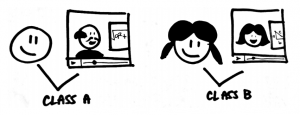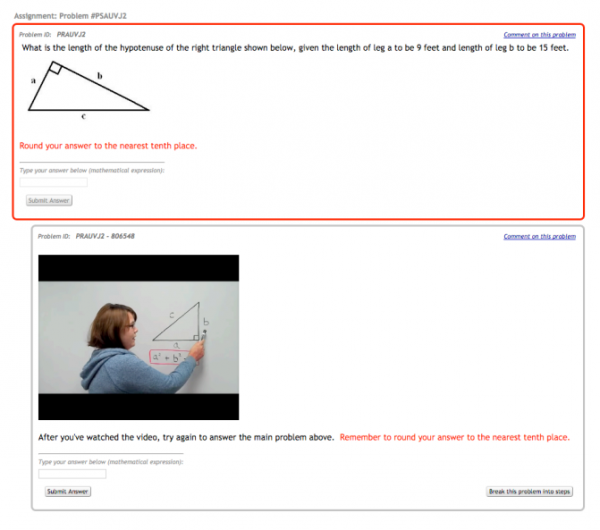Difference between revisions of "Personal Video Hints"
Sfrancisco (talk | contribs) (Edited format) |
Sfrancisco (talk | contribs) m (Edited punctuation) |
||
| Line 5: | Line 5: | ||
|image= Personal Video Hints.png | |image= Personal Video Hints.png | ||
|contributor= [[Paul Salvador Inventado]], [[Peter Scupelli]] | |contributor= [[Paul Salvador Inventado]], [[Peter Scupelli]] | ||
|source= Inventado and Scupelli (in press 2016).<ref name="inventado">Inventado, P.S. & Scupelli, P. | |source= Inventado and Scupelli (in press 2016).<ref name="inventado">Inventado, P.S. & Scupelli, P. (in press 2016). [https://cmu.box.com/shared/static/1tpi6usfvhfj7xhlldyhgm7u5z2pd08t.pdf Patterns for Learning-Support Design in Math Online Learning Systems.] In ''Proceedings of the 23rd Pattern Languages of Programs (PLoP 2016)''. New York:ACM.</ref> | ||
|dataanalysis= <!-- If applicable, list of data analyses used for mining the pattern separated by a " , "comma --> | |dataanalysis= <!-- If applicable, list of data analyses used for mining the pattern separated by a " , "comma --> | ||
|domain= <!-- Learning domain the design pattern belongs to (e.g., General, Math, Algebra) --> | |domain= <!-- Learning domain the design pattern belongs to (e.g., General, Math, Algebra) --> | ||
Latest revision as of 20:37, 6 June 2017
| Personal Video Hints | |
| Contributors | Paul Salvador Inventado, Peter Scupelli |
|---|---|
| Last modification | June 6, 2017 |
| Source | Inventado and Scupelli (in press 2016).[1] |
| Pattern formats | OPR Alexandrian |
| Usability | |
| Learning domain | |
| Stakeholders | |
Use personal videos to make hints more meaningful to students.
Context
Students are asked to answer math problems on an online learning system to help them understand a topic they recently learned.
Problem
The lack of personal connection in hints may cause some students to neglect it.
Forces
- Generic hints. Students may ignore hints if they do not feel it addresses their current situation because it was built to address student concerns in general.
- Misused hints. Students who do not value hints may use it just to get the correct answer instead of learn from it (e.g., consecutive hint requests to reveal the answer).
- Lack of personal connection. Students may lack the feeling of guidance and support when they view generic hints.
Solution
Therefore, provide students with personal videos as hints. Teachers and content designers can identify appropriate hints for particular math problems and create videos that can be presented to students when they request help. Videos can also be created for hints that are already available in the system. Videos do not have to appear too professional. What is important is that students feel a human connection with the learning support provided and it is not just a mechanical system testing their knowledge. In this case, it may even be better for students to see videos from their own teachers. Make sure video hints are not too long so they do not bore the student and present only what is necessary to avoid revealing the solution process or answer too early. This gives students the chance to figure out answers on their own.
Consequences
Benefits
- Personal videos may encourage students to spend time understanding hints because it makes them feel that their concerns are addressed.
- Personal videos may be more meaningful to students so it may discourage them from misusing it.
- Students may feel more support from hints that are presented by an actual person; they may even value hints more if it comes from their own teacher.
Liabilities
- Instructional videos may be more helpful to novice rather than expert students.
- It takes more time and effort to design, create, record, and upload video hints.
- Video hints may need to be created for specific content to have meaningful impact. However, more videos mean more time and effort to create them.
- Videos often take longer to load over the network compared to text, images, or animations.
- Videos may not always appear as intended due to uncontrollable factors (e.g., screen size, color and screen resolution supported, video streaming is not supported, audio is not supported).
Evidence
Literature
- Students spend more time watching and possibly internalizing video hints compared to textual hints[2].
- Students misuse learning systems due to several reasons such as having a fixed-mind set, dislike of the subject matter, lack of self-drive, frustration, and lack of trust in the system[3].
- Students are less likely to misuse video hints because students tend to watch videos instead of skip them. It also takes more effort to find the correct answer in the video[2].
- Students find shorter videos more engaging – six minutes appears to be a good duration[4].
- Students may feel more engaged when videos are personalized or directed at them[4]. Talking-head videos, videos that show teachers’ faces with the content, were also found to be more engaging because they evoked more personal and intimate feelings with students.
Related patterns
The Personal Video Hints design pattern can be used to help facilitate students’ understanding of the problem and may help maintain their motivation as described in the Build and Maintain Confidence design pattern[5]. Use the Keep It Simple design pattern[6] so that unnecessary details do not distract students or reveal learning objectives too quickly. The pattern may also be used to improve hints such as those created with the Represent It and Image-Enhanced Problem design patterns[7], which may suffer from the lack of personal connection.
Example
Isaac Physics is an online learning system that provides students with video hints when they request help in answering problems in the Physics domain. Initial research on the platform showed that video hints helped students learn better[8].
The ASSISTments online learning system allows teachers and content designers to create math problems and associated hints to support student learning. Teachers can create and upload videos that are presented as hints to help students learn better[9]. Research indicates that video hints are more effective than textual hints[2].
The following figure illustrates an example of using video hints in the ASSISTments online learning system. The top box shows the main problem, a problem on the Pythagorean theorem. The box below shows a video hint with the instructor explaining the first step of the Pythagorean theorem: “Substitute the values of the triangle’s sides into variable a and b of the Pythagorean equation to solve for side c”.
References
- ↑ Inventado, P.S. & Scupelli, P. (in press 2016). Patterns for Learning-Support Design in Math Online Learning Systems. In Proceedings of the 23rd Pattern Languages of Programs (PLoP 2016). New York:ACM.
- ↑ 2.0 2.1 2.2 Ostrow, K., & Heffernan, N. (2014). Testing the multimedia principle in the real world: a comparison of video vs. Text feedback in authentic middle school math assignments. In Proceedings of the 7th International Conference on Educational Data Mining (EDM 2014).(pp. 296-299).
- ↑ Baker, R., Walonoski, J., Heffernan, N., Roll, I., Corbett, A., & Koedinger, K. (2008). Why students engage in" gaming the system" behavior in interactive learning environments. Journal of Interactive Learning Research, 19(2), 185.
- ↑ 4.0 4.1 Guo, P. J., Kim, J., & Rubin, R. (2014). How video production affects student engagement: An empirical study of mooc videos. In Proceedings of the first ACM conference on Learning@ scale conference (pp. 41-50). ACM.
- ↑ Bergin, J., Eckstein, J., Völter, M., Sipos, M., Wallingford, E., Marquardt, K., Chandler, J., Sharp, H., and Manns, M.L. (2012). Pedagogical patterns: advice for educators. Joseph Bergin Software Tools.
- ↑ Cunningham and Cunningham Inc. (2014). Keep it Simple. Retrieved from http://c2.com/cgi/wiki?KeepItSimple.when designing video-hint content
- ↑ Inventado, P.S. and Scupelli, P. (2016). Design Patterns for Helping Students to Learn to Visualize Math Problems in Online Learning Systems. In Proceedings of the 21st European Conference on Pattern Languages of Programs (EuroPLoP 2016). New York:ACM.
- ↑ Cummins, S., Stead, A., Jardine-Wright, L., Davies, I., Beresford, A. R., & Rice, A. (2016). Investigating the Use of Hints in Online Problem Solving. In Proceedings of the Third (2016) ACM Conference on Learning@ Scale (pp. 105-108). ACM.
- ↑ Heffernan, N.T. and Heffernan, C.L. (2014). The ASSISTments Ecosystem: Building a Platform that Brings Scientists and Teachers Together for Minimally Invasive Research on Human Learning and Teaching. International Journal of Artificial Intelligence in Education 24(4), 470-497.

